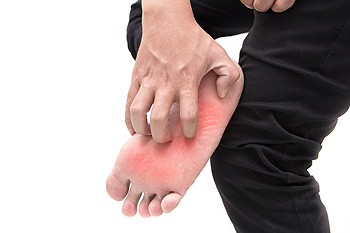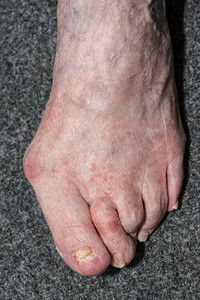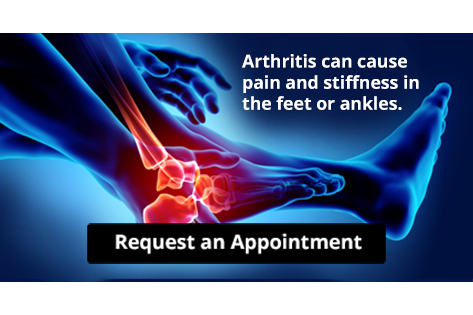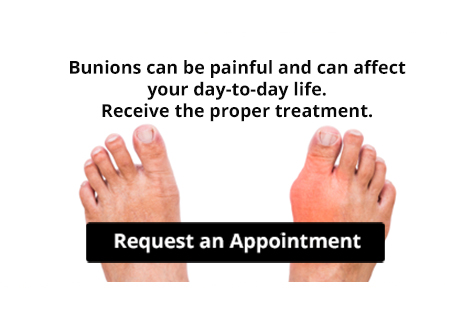Blog
A Numbing Sensation in the Feet May Indicate Poor Circulation
 The medical condition that is known as poor circulation may be indicative of serious health issues. Blood, oxygen, and nutrients are circulated throughout the body, and may be hindered as a result of specific ailments. These can include diabetes, obesity, and certain types of heart conditions. The symptoms that are generally associated with poor circulation can include a numbing or tingling sensation in the feet, sharp pain, and muscle cramps. If poor circulation is not promptly treated, it may lead to a stroke. If you are experiencing any of the mentioned symptoms, it is advised that you speak to a podiatrist as quickly as possible who can determine the cause and offer proper treatment techniques.
The medical condition that is known as poor circulation may be indicative of serious health issues. Blood, oxygen, and nutrients are circulated throughout the body, and may be hindered as a result of specific ailments. These can include diabetes, obesity, and certain types of heart conditions. The symptoms that are generally associated with poor circulation can include a numbing or tingling sensation in the feet, sharp pain, and muscle cramps. If poor circulation is not promptly treated, it may lead to a stroke. If you are experiencing any of the mentioned symptoms, it is advised that you speak to a podiatrist as quickly as possible who can determine the cause and offer proper treatment techniques.
Poor circulation is a serious condition and needs immediate medical attention. If you have any concerns with poor circulation in your feet contact Shaun J. Limon, DPM and Lisa Griffith-Limon, DPM of Limons Foot & Ankle Care. Our doctors will treat your foot and ankle needs.
Poor Circulation in the Feet
Poor blood circulation in the feet and legs is can be caused by peripheral artery disease (PAD), which is the result of a buildup of plaque in the arteries.
Plaque buildup or atherosclerosis results from excess calcium and cholesterol in the bloodstream. This can restrict the amount of blood which can flow through the arteries. Poor blood circulation in the feet and legs are sometimes caused by inflammation in the blood vessels, known as vasculitis.
Causes
Lack of oxygen and oxygen from poor blood circulation restricts muscle growth and development. It can also cause:
- Muscle pain, stiffness, or weakness
- Numbness or cramping in the legs
- Skin discoloration
- Slower nail & hair growth
- Erectile dysfunction
Those who have diabetes or smoke are at greatest risk for poor circulation, as are those who are over 50. If you have poor circulation in the feet and legs it may be caused by PAD and is important to make changes to your lifestyle in order to reduce risk of getting a heart attack or stroke. Exercise and maintaining a healthy lifestyle will dramatically improve conditions.
As always, see a podiatrist as he or she will assist in finding a regimen that suits you. A podiatrist can also prescribe you any needed medication.
If you have any questions please feel free to contact our offices located in Bradenton and Lakewood Ranch, FL . We offer the newest diagnostic and treatment technologies for all your foot and ankle needs.
Read more about Causes, Symptoms, and Treatment of Poor Blood Circulation in the FeetPlantar Warts Can Be Treated!
Existing Medical Conditions May Lead to Foot Wounds
 Wounds on the feet of diabetic patients can develop into a more serious foot condition if they are not treated promptly. An infected wound can progress into a foot ulcer, and this is defined as an open wound that will not heal. There are several reasons why people may not notice they have wounds on the feet. The most common reason is nerve damage, which can make it difficult to feel any changes that occur to the feet. Additionally, existing medical conditions that consist of kidney failure, high blood pressure, and cholesterol, can contribute to the onset of foot wounds. If you are prone to developing wounds on the feet, it is suggested that you schedule an appointment with a podiatrist who can properly diagnose and help you with correct treatment options.
Wounds on the feet of diabetic patients can develop into a more serious foot condition if they are not treated promptly. An infected wound can progress into a foot ulcer, and this is defined as an open wound that will not heal. There are several reasons why people may not notice they have wounds on the feet. The most common reason is nerve damage, which can make it difficult to feel any changes that occur to the feet. Additionally, existing medical conditions that consist of kidney failure, high blood pressure, and cholesterol, can contribute to the onset of foot wounds. If you are prone to developing wounds on the feet, it is suggested that you schedule an appointment with a podiatrist who can properly diagnose and help you with correct treatment options.
Wound care is an important part in dealing with diabetes. If you have diabetes and a foot wound or would like more information about wound care for diabetics, consult with Shaun J. Limon, DPM and Lisa Griffith-Limon, DPM from Limons Foot & Ankle Care. Our doctors will assess your condition and provide you with quality foot and ankle treatment.
What Is Wound Care?
Wound care is the practice of taking proper care of a wound. This can range from the smallest to the largest of wounds. While everyone can benefit from proper wound care, it is much more important for diabetics. Diabetics often suffer from poor blood circulation which causes wounds to heal much slower than they would in a non-diabetic.
What Is the Importance of Wound Care?
While it may not seem apparent with small ulcers on the foot, for diabetics, any size ulcer can become infected. Diabetics often also suffer from neuropathy, or nerve loss. This means they might not even feel when they have an ulcer on their foot. If the wound becomes severely infected, amputation may be necessary. Therefore, it is of the upmost importance to properly care for any and all foot wounds.
How to Care for Wounds
The best way to care for foot wounds is to prevent them. For diabetics, this means daily inspections of the feet for any signs of abnormalities or ulcers. It is also recommended to see a podiatrist several times a year for a foot inspection. If you do have an ulcer, run the wound under water to clear dirt from the wound; then apply antibiotic ointment to the wound and cover with a bandage. Bandages should be changed daily and keeping pressure off the wound is smart. It is advised to see a podiatrist, who can keep an eye on it.
If you have any questions, please feel free to contact our offices located in Bradenton and Lakewood Ranch, FL . We offer the newest diagnostic and treatment technologies for all your foot care needs.
Read more about Wound CareWalking Shoes May Offer Less Stability Than Running Shoes
 Research has indicated the importance of wearing shoes that fit correctly while walking and running. There are shoes that are specifically designed for your chosen sport, and it is beneficial to be aware of how the foot strikes the ground. When the proper shoes are worn, the muscles and joints in the feet can function optimally, which can provide a more enjoyable walk or run. Running shoes have more cushioning than walking shoes, and may be lighter in weight. Many running shoes are designed with a mesh material, and this can help the feet to easily sweat as energy is expended. Walking shoes have more of a flexible sole than running shoes, and it may not be necessary to have the same type of stability. If you would like additional information about the differences between walking and running shoes, a podiatrist can provide you with the correct knowledge.
Research has indicated the importance of wearing shoes that fit correctly while walking and running. There are shoes that are specifically designed for your chosen sport, and it is beneficial to be aware of how the foot strikes the ground. When the proper shoes are worn, the muscles and joints in the feet can function optimally, which can provide a more enjoyable walk or run. Running shoes have more cushioning than walking shoes, and may be lighter in weight. Many running shoes are designed with a mesh material, and this can help the feet to easily sweat as energy is expended. Walking shoes have more of a flexible sole than running shoes, and it may not be necessary to have the same type of stability. If you would like additional information about the differences between walking and running shoes, a podiatrist can provide you with the correct knowledge.
For more information about walking shoes versus running shoes, consult with Shaun J. Limon, DPM and Lisa Griffith-Limon, DPM from Limons Foot & Ankle Care. Our doctors can measure your feet to determine what your needs are and help you find an appropriate pair of footwear.
Foot Health: The Differences between Walking & Running Shoes
There are great ways to stay in shape: running and walking are two great exercises to a healthy lifestyle. It is important to know that running shoes and walking shoes are not interchangeable. There is a key difference on how the feet hit the ground when someone is running or walking. This is why one should be aware that a shoe is designed differently for each activity.
You may be asking yourself what the real differences are between walking and running shoes and the answers may shock you.
Differences
Walking doesn’t involve as much stress or impact on the feet as running does. However, this doesn’t mean that you should be any less prepared. When you’re walking, you land on your heels and have your foot roll forward. This rolling motion requires additional support to the feet.
Flexibility – Walking shoes are designed to have soft, flexible soles. This allows the walker to push off easily with each step.
If you have any questions, please feel free to contact our offices located in Bradenton and Lakewood Ranch, FL . We offer the newest diagnostic and treatment technologies for all your foot care needs.
Read more about Walking Shoes vs. Running ShoesArthritis Can Cause Pain in the Feet and Ankles
How Did I Contract Athlete’s Foot?
 Skin that is red and peeling between the toes can be indicative of a condition that is known as athlete’s foot. It is a fungal infection, and is caused by fungus that lives and thrives in warm and moist environments. These can consist of public swimming pools, locker rooms, and communal showers. Additional symptoms may include severe itchiness, blisters, and the skin may become thick and cracked. Helpful prevention methods can involve wearing appropriate shoes while in these areas, followed by washing and drying the feet thoroughly. Athlete’s feet can cause pain and discomfort. If you think you are afflicted with this ailment, it is strongly suggested that you consult with a podiatrist who can prescribe the necessary medication for an effective treatment.
Skin that is red and peeling between the toes can be indicative of a condition that is known as athlete’s foot. It is a fungal infection, and is caused by fungus that lives and thrives in warm and moist environments. These can consist of public swimming pools, locker rooms, and communal showers. Additional symptoms may include severe itchiness, blisters, and the skin may become thick and cracked. Helpful prevention methods can involve wearing appropriate shoes while in these areas, followed by washing and drying the feet thoroughly. Athlete’s feet can cause pain and discomfort. If you think you are afflicted with this ailment, it is strongly suggested that you consult with a podiatrist who can prescribe the necessary medication for an effective treatment.
Athlete’s Foot
Athlete’s foot is often an uncomfortable condition to experience. Thankfully, podiatrists specialize in treating athlete’s foot and offer the best treatment options. If you have any questions about athlete’s foot, consult with Shaun J. Limon, DPM and Lisa Griffith-Limon, DPM from Limons Foot & Ankle Care. Our doctors will assess your condition and provide you with quality treatment.
What Is Athlete’s Foot?
Tinea pedis, more commonly known as athlete’s foot, is a non-serious and common fungal infection of the foot. Athlete’s foot is contagious and can be contracted by touching someone who has it or infected surfaces. The most common places contaminated by it are public showers, locker rooms, and swimming pools. Once contracted, it grows on feet that are left inside moist, dark, and warm shoes and socks.
Prevention
The most effective ways to prevent athlete’s foot include:
- Thoroughly washing and drying feet
- Avoid going barefoot in locker rooms and public showers
- Using shower shoes in public showers
- Wearing socks that allow the feet to breathe
- Changing socks and shoes frequently if you sweat a lot
Symptoms
Athlete’s foot initially occurs as a rash between the toes. However, if left undiagnosed, it can spread to the sides and bottom of the feet, toenails, and if touched by hand, the hands themselves. Symptoms include:
- Redness
- Burning
- Itching
- Scaly and peeling skin
Diagnosis and Treatment
Diagnosis is quick and easy. Skin samples will be taken and either viewed under a microscope or sent to a lab for testing. Sometimes, a podiatrist can diagnose it based on simply looking at it. Once confirmed, treatment options include oral and topical antifungal medications.
If you have any questions, please feel free to contact our offices located in Bradenton and Lakewood Ranch, FL . We offer the newest diagnostic and treatment technologies for all your foot care needs.
Read more about Athlete's Foot
Are Flip Flops Safe to Wear?
 Flip flops are a common type of shoe that are worn during the warmer months. They are designed in a variety of colors and styles, and are generally inexpensive and easy to wear. Despite their popularity, people who frequently wear flip flops may actually be damaging their feet. This may occur as a result of a lack of support, and can cause uncomfortable foot conditions to develop. These can consist of cracked heels that can come from wearing a thin sole, and hammertoes, which may be caused by the toes gripping the front of the shoe. Additionally, the ankle may roll inwards to compensate for the inadequate support, which may cause instability in walking. If you are interested in learning more about the effects flip flops may have on the feet, please consult with a podiatrist.
Flip flops are a common type of shoe that are worn during the warmer months. They are designed in a variety of colors and styles, and are generally inexpensive and easy to wear. Despite their popularity, people who frequently wear flip flops may actually be damaging their feet. This may occur as a result of a lack of support, and can cause uncomfortable foot conditions to develop. These can consist of cracked heels that can come from wearing a thin sole, and hammertoes, which may be caused by the toes gripping the front of the shoe. Additionally, the ankle may roll inwards to compensate for the inadequate support, which may cause instability in walking. If you are interested in learning more about the effects flip flops may have on the feet, please consult with a podiatrist.
Flip-flops can cause a lot of problems for your feet. If you have any concerns about your feet or ankles, contact Shaun J. Limon, DPM and Lisa Griffith-Limon, DPM from Limons Foot & Ankle Care. Our doctors will assist you with all of your foot and ankle needs.
Flip-Flops and Feet
Flip-flops have managed to become a summer essential for a lot of people. While the shoes may be stylish and easy to slip on and off, they can be dangerous to those who wear them too often. These shoes might protect you from fungal infections such as athlete’s foot, but they can also give you foot pain and sprained ankles if you trip while wearing them.
When Are They Okay to Wear?
Flip-flops should only be worn for very short periods of time. They can help protect your feet in places that are crawling with fungi, such as gym locker rooms. Athlete’s foot and plantar warts are two common fungi that flip-flops may help protect your feet against.
Why Are They Bad for My Feet?
These shoes do not offer any arch support, so they are not ideal for everyday use. They also do not provide shock absorption or heel cushioning which can be problematic for your feet. Additionally, you may suffer from glass cuts, puncture wounds, and stubbed toes since they offer little protection for your feet.
More Reasons Why They Are Bad for Your Feet
- They Slow You Down
- May Cause Blisters and Calluses
- Expose Your Feet to Bacteria
If you have any questions, please feel free to contact our offices located in Bradenton and Lakewood Ranch, FL . We offer the newest diagnostic and treatment technologies for all your foot care needs.
Read more about Flip Flops and Your FeetGout Pain Can Be Managed
Does Flat Feet Cause Pain?
 There is a simple technique that can determine if you have flat feet. This is done by simply standing and noticing if your entire foot lies flat on the floor. Patients who have this condition do not have an arch, and this condition may be accompanied by pain and discomfort. If you are diagnosed with flat feet, it may be beneficial to wear orthotics that can help to provide the support that is needed to complete daily activities. Some patients find mild relief when specific foot stretches are performed, as this may help to strengthen the overall foot. If you have been born with flat feet, please consult with a podiatrist who can manage any existing pain that comes from this condition.
There is a simple technique that can determine if you have flat feet. This is done by simply standing and noticing if your entire foot lies flat on the floor. Patients who have this condition do not have an arch, and this condition may be accompanied by pain and discomfort. If you are diagnosed with flat feet, it may be beneficial to wear orthotics that can help to provide the support that is needed to complete daily activities. Some patients find mild relief when specific foot stretches are performed, as this may help to strengthen the overall foot. If you have been born with flat feet, please consult with a podiatrist who can manage any existing pain that comes from this condition.
Flatfoot is a condition many people suffer from. If you have flat feet, contact Shaun J. Limon, DPM and Lisa Griffith-Limon, DPM from Limons Foot & Ankle Care. Our doctors will treat your foot and ankle needs.
What Are Flat Feet?
Flatfoot is a condition in which the arch of the foot is depressed and the sole of the foot is almost completely in contact with the ground. About 20-30% of the population generally has flat feet because their arches never formed during growth.
Conditions & Problems:
Having flat feet makes it difficult to run or walk because of the stress placed on the ankles.
Alignment – The general alignment of your legs can be disrupted, because the ankles move inward which can cause major discomfort.
Knees – If you have complications with your knees, flat feet can be a contributor to arthritis in that area.
Symptoms
- Pain around the heel or arch area
- Trouble standing on the tip toe
- Swelling around the inside of the ankle
- Flat look to one or both feet
- Having your shoes feel uneven when worn
Treatment
If you are experiencing pain and stress on the foot you may weaken the posterior tibial tendon, which runs around the inside of the ankle.
If you have any questions please feel free to contact our offices located in Bradenton and Lakewood Ranch, FL . We offer the newest diagnostic and treatment technologies for all your foot and ankle needs.
Read more about What is Flexible Flat Foot?Is a Fear of Falling Common Among Seniors?
 Falling is an unnatural action, and the fear of falling may limit older Americans from accomplishing daily activities. Research has indicated that falling is a common cause of injuries among elderly people, and their lives may change considerably following a fall. Methods may be implemented which can help to prevent falling. These can consist of removing clutter, replacing worn rugs that can be easily slipped on, and improving lighting in the household. Additionally, it is beneficial to perform gentle stretching exercises which may help to increase the overall strength in the body. Many people choose to install grab bars in the toilet and shower areas, as this may help to provide necessary support. Please consult with a podiatrist to learn about additional preventive measures, and to understand how falling can impact the feet and ankles.
Falling is an unnatural action, and the fear of falling may limit older Americans from accomplishing daily activities. Research has indicated that falling is a common cause of injuries among elderly people, and their lives may change considerably following a fall. Methods may be implemented which can help to prevent falling. These can consist of removing clutter, replacing worn rugs that can be easily slipped on, and improving lighting in the household. Additionally, it is beneficial to perform gentle stretching exercises which may help to increase the overall strength in the body. Many people choose to install grab bars in the toilet and shower areas, as this may help to provide necessary support. Please consult with a podiatrist to learn about additional preventive measures, and to understand how falling can impact the feet and ankles.
Preventing falls among the elderly is very important. If you are older and have fallen or fear that you are prone to falling, consult with Shaun J. Limon, DPM and Lisa Griffith-Limon, DPM from Limons Foot & Ankle Care. Our doctors will assess your condition and provide you with quality advice and care.
Every 11 seconds, an elderly American is being treated in an emergency room for a fall related injury. Falls are the leading cause of head and hip injuries for those 65 and older. Due to decreases in strength, balance, senses, and lack of awareness, elderly persons are very susceptible to falling. Thankfully, there are a number of things older persons can do to prevent falls.
How to Prevent Falls
Some effective methods that older persons can do to prevent falls include:
- Enrolling in strength and balance exercise program to increase balance and strength
- Periodically having your sight and hearing checked
- Discuss any medications you have with a doctor to see if it increases the risk of falling
- Clearing the house of falling hazards and installing devices like grab bars and railings
- Utilizing a walker or cane
- Wearing shoes that provide good support and cushioning
- Talking to family members about falling and increasing awareness
Falling can be a traumatic and embarrassing experience for elderly persons; this can make them less willing to leave the house, and less willing to talk to someone about their fears of falling. Doing such things, however, will increase the likelihood of tripping or losing one’s balance. Knowing the causes of falling and how to prevent them is the best way to mitigate the risk of serious injury.
If you have any questions, please feel free to contact our offices located in Bradenton and Lakewood Ranch, FL . We offer the newest diagnostic and treatment technologies for all your foot care needs.
Read more about Falls PreventionMore...
Are Bunions Affecting Your Everyday Life?
Possible Treatment for Bunions
 Patients who have bunions are generally aware of the pain and discomfort they may cause while wearing shoes. It is defined as a small bony growth that gradually forms on the side of the big toe, and can come from wearing shoes that do not have adequate room for the toes to move freely in. Additionally, genetic factors may play a significant role in the development of a bunion. There are noticeable symptoms that are often associated with bunions. These can include calluses that can develop on top of the bunion, and the big toe may point toward the other toes. Relief may be found when larger shoes are worn that can accommodate the protruding bone, in addition to wearing a pad over the affected area. In severe cases, surgery may be an option to consider for permanent removal. If you have developed a bunion, please consult with a podiatrist who can properly diagnose this condition and determine what the best treatment is for you.
Patients who have bunions are generally aware of the pain and discomfort they may cause while wearing shoes. It is defined as a small bony growth that gradually forms on the side of the big toe, and can come from wearing shoes that do not have adequate room for the toes to move freely in. Additionally, genetic factors may play a significant role in the development of a bunion. There are noticeable symptoms that are often associated with bunions. These can include calluses that can develop on top of the bunion, and the big toe may point toward the other toes. Relief may be found when larger shoes are worn that can accommodate the protruding bone, in addition to wearing a pad over the affected area. In severe cases, surgery may be an option to consider for permanent removal. If you have developed a bunion, please consult with a podiatrist who can properly diagnose this condition and determine what the best treatment is for you.
If you are suffering from bunion pain, contact Shaun J. Limon, DPM and Lisa Griffith-Limon, DPM of Limons Foot & Ankle Care. Our doctors can provide the care you need to keep you pain-free and on your feet.
What Is a Bunion?
Bunions are painful bony bumps that usually develop on the inside of the foot at the joint of the big toe. As the deformity increases over time, it may become painful to walk and wear shoes. Women are more likely to exacerbate existing bunions since they often wear tight, narrow shoes that shift their toes together. Bunion pain can be relieved by wearing wider shoes with enough room for the toes.
Causes
- Genetics – some people inherit feet that are more prone to bunion development
- Inflammatory Conditions - rheumatoid arthritis and polio may cause bunion development
Symptoms
- Redness and inflammation
- Pain and tenderness
- Callus or corns on the bump
- Restricted motion in the big toe
In order to diagnose your bunion, your podiatrist may ask about your medical history, symptoms, and general health. Your doctor might also order an x-ray to take a closer look at your feet. Nonsurgical treatment options include orthotics, padding, icing, changes in footwear, and medication. If nonsurgical treatments don’t alleviate your bunion pain, surgery may be necessary.
If you have any questions, please feel free to contact our offices located in Bradenton and Lakewood Ranch, FL . We offer the newest diagnostic and treatment technologies for all your foot care needs.
Read more about What Are Bunions?Possible Causes of Plantar Fasciitis
 The painful foot condition that is known as plantar fasciitis is a common foot ailment. It is an inflammation of the plantar fascia, which is the portion of tissue that connects the toes to the heels. It typically occurs gradually, and can develop from wearing shoes that do not fit correctly. Many patients find they are afflicted with plantar fasciitis when they stand for extended periods of time throughout the day, and it may be accelerated while standing on hard surfaces. Additional causes can include obesity, an increase in performing sporting activities, or it may develop from a foot structure deformity. There are a variety of treatment methods that may help to provide patients relief. It is strongly suggested that you are under the care of a podiatrist who can determine which is the best type of treatment for you.
The painful foot condition that is known as plantar fasciitis is a common foot ailment. It is an inflammation of the plantar fascia, which is the portion of tissue that connects the toes to the heels. It typically occurs gradually, and can develop from wearing shoes that do not fit correctly. Many patients find they are afflicted with plantar fasciitis when they stand for extended periods of time throughout the day, and it may be accelerated while standing on hard surfaces. Additional causes can include obesity, an increase in performing sporting activities, or it may develop from a foot structure deformity. There are a variety of treatment methods that may help to provide patients relief. It is strongly suggested that you are under the care of a podiatrist who can determine which is the best type of treatment for you.
Plantar fasciitis can be very painful and inconvenient. If you are experiencing heel pain or symptoms of plantar fasciitis, contact Shaun J. Limon, DPM and Lisa Griffith-Limon, DPM from Limons Foot & Ankle Care. Our doctors can provide the care you need to keep you pain-free and on your feet.
What Is Plantar Fasciitis?
Plantar fasciitis is the inflammation of the thick band of tissue that runs along the bottom of your foot, known as the plantar fascia, and causes mild to severe heel pain.
What Causes Plantar Fasciitis?
- Excessive running
- Non-supportive shoes
- Overpronation
- Repeated stretching and tearing of the plantar fascia
How Can It Be Treated?
- Conservative measures – anti-inflammatories, ice packs, stretching exercises, physical therapy, orthotic devices
- Shockwave therapy – sound waves are sent to the affected area to facilitate healing and are usually used for chronic cases of plantar fasciitis
- Surgery – usually only used as a last resort when all else fails. The plantar fascia can be surgically detached from the heel
While very treatable, plantar fasciitis is definitely not something that should be ignored. Especially in severe cases, speaking to your doctor right away is highly recommended to avoid complications and severe heel pain. Your podiatrist can work with you to provide the appropriate treatment options tailored to your condition.
If you have any questions please feel free to contact our offices located in Bradenton and Lakewood Ranch, FL . We offer the newest diagnostic and treatment technologies for all your foot and ankle needs.
Read more about Plantar Fasciitis




